Preparing to plant in Spring
By Peggy Ashbrook
Posted on 2016-12-02
 The seasonal decline in the amount of direct sunlight in North America is bringing an end to my garden growing season. The leaves of deciduous trees in my region are mostly off the trees now. Children have been helping rake them into big piles to jump into. We sort out the sticks so no one gets poked when they jump. A few children with allergies to mold choose other tasks to tend the play area: reseeding the grassy places and washing the fence with water. As we pile up the leaves I’m thinking of how we will use them for mulch in the garden bed to prevent weed growth over the winter. What looks like a large amount now will be much reduced by weathering and the work of detritivores such as isopods, just one of those small animals that eat decaying plant matter.
The seasonal decline in the amount of direct sunlight in North America is bringing an end to my garden growing season. The leaves of deciduous trees in my region are mostly off the trees now. Children have been helping rake them into big piles to jump into. We sort out the sticks so no one gets poked when they jump. A few children with allergies to mold choose other tasks to tend the play area: reseeding the grassy places and washing the fence with water. As we pile up the leaves I’m thinking of how we will use them for mulch in the garden bed to prevent weed growth over the winter. What looks like a large amount now will be much reduced by weathering and the work of detritivores such as isopods, just one of those small animals that eat decaying plant matter.
 Isopods (aka roly-polies, pillbugs, slaters, wood lice, potato bugs and other names) are my favorite animal to keep in containers for children to observe and handle. They are easy to find, require just a little attention, and are safe and durable for handling. Children learn about diversity in living organisms, how to best use magnifiers while counting the number of legs on these small crustaceans, and how to provide the needs of an animal that is so different from themselves. Learn more at:
Isopods (aka roly-polies, pillbugs, slaters, wood lice, potato bugs and other names) are my favorite animal to keep in containers for children to observe and handle. They are easy to find, require just a little attention, and are safe and durable for handling. Children learn about diversity in living organisms, how to best use magnifiers while counting the number of legs on these small crustaceans, and how to provide the needs of an animal that is so different from themselves. Learn more at:
Animal Diversity Web from the University of Michigan
YouTube videos
Rusty & Ollie’s Fun, Facts, and Follies. Episode 13: Isopods! Nature’s Janitors. This conversation between the chill Mr. Max and the excitable puppet Rusty is informative and fun.
Rebecca Hulit’s informative Isopods – Backyard Critters shows close ups of the isopods so we can see the leg segments and more.
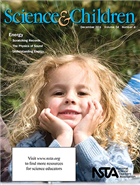 I am planning to plant potatoes in the spring and wrote about this gardening activity in the December 2016 Early Years column in Science and Children. Using the area extension service and other websites I learned that the temperature of the soil is important in determining best potato planting time.
I am planning to plant potatoes in the spring and wrote about this gardening activity in the December 2016 Early Years column in Science and Children. Using the area extension service and other websites I learned that the temperature of the soil is important in determining best potato planting time.
Extension services provide valuable advice and research for home gardeners and commercial agriculture. Extension Horticulturist Ron Smith of the North Dakota State University answers questions in the Hortiscope. The University of Maryland Extension provides Vegetable Profiles online, and the Iowa State Extension and Outreach has articles on Yard and Garden planting.
Although we eat the tubers of the potato plant, their leaves, stems, flowers and fruits contain poisonous compounds and can cause stomach pain, diarrhea and additional serious symptoms, so they should not be eaten. While we can use children’s ages as a rough guide to when they will have good judgment about what is safe to put in their mouths, there are always children who explore unsafely. There is no substitute for knowing our students and supervising appropriately. Planting edible leaved plants such as herbs in a different area than potato plants is one way to help children learn which plant leaves are safe to eat.
 The topic of beginning a small school garden is on-going on the Early Childhood forum in the NSTA Learning Center. Will you make a quick comment to share your experience to help other teachers begin or improve their gardening? What tips do you use in your gardening that could help others be successful? Registration to join this community is free for all.
The topic of beginning a small school garden is on-going on the Early Childhood forum in the NSTA Learning Center. Will you make a quick comment to share your experience to help other teachers begin or improve their gardening? What tips do you use in your gardening that could help others be successful? Registration to join this community is free for all.
 The seasonal decline in the amount of direct sunlight in North America is bringing an end to my garden growing season. The leaves of deciduous trees in my region are mostly off the trees now. Children have been helping rake them into big piles to jump into. We sort out the sticks so no one gets poked when they jump.
The seasonal decline in the amount of direct sunlight in North America is bringing an end to my garden growing season. The leaves of deciduous trees in my region are mostly off the trees now. Children have been helping rake them into big piles to jump into. We sort out the sticks so no one gets poked when they jump.
Teacher as scientist
By Mary Bigelow
Posted on 2016-11-30
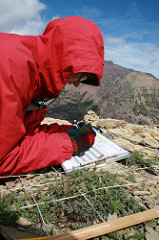 I have a degree in biology and teach high school. Although I love teaching at this level, I miss doing real scientific work myself. Any suggestions on how I can still stay engaged and current in science? —T., Illinois
I have a degree in biology and teach high school. Although I love teaching at this level, I miss doing real scientific work myself. Any suggestions on how I can still stay engaged and current in science? —T., Illinois
Although we teach a variety of topics, teachers have areas of special interests. And as we teach unfamiliar topics, we may discover new interests. Social media is a good way to find out more about ways to continue and expand on your interests. Some options you could explore include:
- Participating in programs from universities or government agencies that help teachers contribute to investigations over the summer and to partner with researchers. Your alma mater or a nearby college/university may have such a program.
- Attending programs and presentations at universities, museums, medical centers, parks, or science centers to update your knowledge and foster connections with researchers and other science professionals.
- Volunteering your expertise and expertise at nature centers or museums.
- Inviting scientists to your classroom to share their experiences and expertise and perhaps work with your students. Some science partnership projects with higher education facilitate these interactions.
- Reading science journals and publications, many of which are available online. Share with your students.
- Using summer and term breaks to visit museums, science centers, national parks, and so on. If you let the staff know ahead of time you’re a teacher, you may get the red carpet treatment with an in-depth or behind-the-scenes tour.
- Contributing to continuing investigations through citizen science projects (see the SciStarter website for projects in which both you and your students can participate)
As science teachers, we have an obligation to model lifelong learning for our students. And they enjoy finding out about our “secret” lives and interests and passions.
Inquiring Scientists, Inquiring Readers in Middle School: Using Nonfiction to Promote Science Literacy
Four New Books for Young Scientists
By Carole Hayward
Posted on 2016-11-27
Studies show that science is students’ favorite subject when they enter school for the first time. Why? Kids are curious and creative. They love asking questions based on their observations. They love discovering everything. When kids are young, the world is wonderful, magical, and full of possibilities.
NSTA Kids, a division of NSTA Press, recently released four new books to inspire kids’ imagination and encourage them to ask questions about the world around them.
Quiet as a Butterfly by Lawrence F. Lowery is part of the I Wonder Why series designed to help students in grades K-3 to explore their senses. Sounds take center stage in this story. “One day, I listened. I listened to all the sounds I heard. I listened, and I wondered,” the narrator says. He contemplates sounds including birds singing, roosters crowing, and his mother humming, while also wondering about things that move about without making a sound like butterflies, caterpillars, and ladybugs.
by Lawrence F. Lowery is part of the I Wonder Why series designed to help students in grades K-3 to explore their senses. Sounds take center stage in this story. “One day, I listened. I listened to all the sounds I heard. I listened, and I wondered,” the narrator says. He contemplates sounds including birds singing, roosters crowing, and his mother humming, while also wondering about things that move about without making a sound like butterflies, caterpillars, and ladybugs.
Fragrant as a Flower by Lawrence F. Lowery from the I Wonder Why series explores the connection between smell and memories. A boy explores the city, reliving a story that his father had told him about the smells of his childhood. “My dad likes to tell stories. One story he tells is about his walk around town when he was my age. He had fun exploring smells,” says the narrator. From the pastry shop to the tire shop, from fresh asphalt to old shoes, each scent tells a tale.
by Lawrence F. Lowery from the I Wonder Why series explores the connection between smell and memories. A boy explores the city, reliving a story that his father had told him about the smells of his childhood. “My dad likes to tell stories. One story he tells is about his walk around town when he was my age. He had fun exploring smells,” says the narrator. From the pastry shop to the tire shop, from fresh asphalt to old shoes, each scent tells a tale.
Look and See is the third new book by Lawrence F. Lowery from the I Wonder Why series. “Scientists learn by observing, comparing, and organizing the objects and ideas they are investigating. Children learn the same way,” the book’s introduction states. “Our senses—sight, hearing, touch, smell, and taste—provide our brains with information about our world.” In this delightful book, young readers can practice making observations and comparisons and looking for patterns.
is the third new book by Lawrence F. Lowery from the I Wonder Why series. “Scientists learn by observing, comparing, and organizing the objects and ideas they are investigating. Children learn the same way,” the book’s introduction states. “Our senses—sight, hearing, touch, smell, and taste—provide our brains with information about our world.” In this delightful book, young readers can practice making observations and comparisons and looking for patterns.
Next Time You See a Cloud by Emily Morgan offers a note to parents and teachers about how to use the text. This book should be used in tandem with real-life observation. “Go outside on a day when you see white clouds against the blue sky. Lie down on the ground together and observe the clouds. Notice their different shapes and sizes and the directions in which they move. Use your imagination to see different forms. Talk about what you observe and share what you wonder.” Morgan’s book explains how clouds form, how they move, and why they look the way they do.
by Emily Morgan offers a note to parents and teachers about how to use the text. This book should be used in tandem with real-life observation. “Go outside on a day when you see white clouds against the blue sky. Lie down on the ground together and observe the clouds. Notice their different shapes and sizes and the directions in which they move. Use your imagination to see different forms. Talk about what you observe and share what you wonder.” Morgan’s book explains how clouds form, how they move, and why they look the way they do.
Captivate young scientists with these fun and engaging new books that let them use their imagination and all of their senses to discover and learn. These books are also available as e-books.
Follow NSTA
Save
Studies show that science is students’ favorite subject when they enter school for the first time. Why? Kids are curious and creative. They love asking questions based on their observations. They love discovering everything. When kids are young, the world is wonderful, magical, and full of possibilities.
NSTA Kids, a division of NSTA Press, recently released four new books to inspire kids’ imagination and encourage them to ask questions about the world around them.
Suggestions for a lab update
By Mary Bigelow
Posted on 2016-11-27
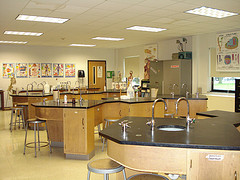 I have a chance to contribute to the design of the science classrooms in a middle school. What should be on a “must-have” list? —S., Connecticut
I have a chance to contribute to the design of the science classrooms in a middle school. What should be on a “must-have” list? —S., Connecticut
I would strongly recommend using the NSTA Guide to Planning School Science Facilities. This publication has a chapter on safety guidelines (including material storage), sample floorplans, Americans with Disabilities Act guidelines, and even suggestions for “green” labs. It has chapters on the planning process, photographs, checklists, and discussion-starters.
Check on the recommendations or requirements from your state department of education and your local building codes. Consider the age level of your students and the type of activities and investigations in your curriculum.
The first priority should be safety features such as showers, eyewash stations, fume hoods, air exchange, fire extinguishers and blankets, sanitizing equipment for goggles, master shut-off switches for utilities, adequate and uncluttered workspaces, and unobstructed exits from the lab.
Other science teachers offer their advice:
- Include more storage space than you think you’ll need. Drawers and cupboards should be lockable.
- In addition to lab stations, get flat student desks or tables that can be pushed together for cooperative work and projects.
- You can’t have too many electrical outlets throughout the room.
- It is helpful to visit labs and talk to the teachers at other schools when planning a new lab space.
- Have a small refrigerator for making ice or chilling materials (but not for lunches!).
It’s better to work out the details first rather than having to go back and correct any mistakes or omissions. Include your administrators in any design discussions. From my own experience, architects, contractors, or administrators may try to skimp on features you recommend. Be adamant about student safety and ensuring the facility meets the learning needs of science students.
Update: S has followed up with “We met with the architects today and that book was very helpful.”
7 Ways to Get Funding to Attend an NSTA Conference
By Guest Blogger
Posted on 2016-11-23
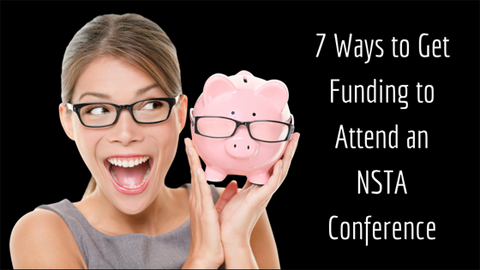
If you’ve ever been to an NSTA conference, you know you go home SO pumped up by what you saw and learned there that you want desperately to go the NSTA National Conference and/or the 6th Annual STEM Forum & Expo! Unfortunately, you know there is no way that you can afford it, and you doubt you can get funding from your administrators to go to another conference. Well, maybe there is a way to find funding so you can attend an upcoming NSTA conference; I have a few tips and tricks to share that might help you.
Tip #1: Check the Date
The NSTA National Conference does fall within the same fiscal year as our area conferences, so it might be harder to double dip on the professional development budget this school year. However, take a closer look at the STEM Forum & Expo’s dates: July 12–14, 2107. This is actually the start of the NEW budget year for the 2017–2018 school year. Carefully point this out to your administrator and remind them that you are asking for the FIRST professional development opportunity of the new school year. There will definitely be money available at the start of the fiscal year. You may find it helpful to bring a justification letter to share. Download one for the National conference here, and read more about the PD you’ll get at the STEM Forum & Expo here.
Tip #2: Present at an NSTA Conference
I know you might be saying to yourself “I could never get up in front of others and talk about my classroom,” but I am here to say you can! Each and every one of us has one great idea, fabulous project, or fantastic unit of study that will help our fellow colleagues improve their teaching. When you approach your administration about funding for an NSTA Conference or the STEM Forum & Expo, you are giving yourself professional credibility when you say “I am presenting at the NSTA __________ conference.” Your service to your colleagues goes a long way when asking for funding. It provides your school and school district with a way to promote something good to your local school board and to the larger community by way of your school/alumni newsletter, local television news or newspaper. Come on you can do it. Find out more about submitting session proposals here. The next round is due December 5, so don’t wait.
Tip #3: Apply for an NSTA Award
The annual NSTA Awards and Recognition Program recognizes exceptional and innovative science educators. This awards program helps to raise awareness of the outstanding work being done in science classrooms around the country each year. With 20 different awards, there are many options to apply for in the program. Make sure you follow the specific criteria for the award you are applying for. Be sure you read the details before submitting your application. Some awards come with a monetary gift that can be used toward expenses to attend the NSTA National Conference. In addition, award winners are celebrated at the Awards Banquet during the conference. It is a great way to let our colleagues and the world know of the outstanding work happening each and every day in your classroom.
Tip #4: Ask Your Business and Industry Partners
Many schools, especially STEM schools, have business and industry partners that give supplies, time, personnel, and funding to schools. Why not write a letter asking your partners to fund at least part of your trip? In your letter explain what conference you want to attend, how it would benefit and improve student performance, and how it helps to move you and your school forward. While your business and industry partners may only fund a portion of your trip, it is some funding that you did not have before. Plus, it could be the impetus to get funding from other community groups and partners. Try it! All they can say is no.
Tip #5: Ask Local Service and Civic Organizations
Civic and service organizations like the Rotary International, Kiwanis Club, Lions Club, and the Optimists are groups of local business leaders and service-minded individuals that meet with a common belief or cause. Many of these groups lend service to our local schools with fund raisers, service hours, and in-kind donations. Why not write another letter asking these groups to fund at least part of your trip? Just as in the letter to your school’s business and industry partners, explain what conference you want to attend, how it would benefit and improve student performance and your performance as an educator, and how it helps to move your school forward. While these groups may fund only a portion of your trip, it’s funding that you did not have before and you may get more than one organization to help you.
Tip #6: Write Off Some of Your Expenses on Your Taxes
First thing… I am not a tax professional! Attending conferences like the National Conference or the STEM Forum & Expo are a normal part of the education world and are considered business expenses. You should be able to deduct travel expenses for any conferences you attend. This includes your airfare, lodging, and (depending on distance) food. If these expenses are not reimbursed by your school or school district, you should be able to write them off. But consult your local tax professional, since I am not a tax professional.
Tip #7: Create a GoFundMe Fundraising Campaign
Crowd funding is hot! We all know that sites like GoFundMe where people post a brief write up (some have videos) about the project they would like members of public to support. It is quick and easy. You can link your fundraiser to your Twitter or Facebook account for more exposure. People seeing your fundraiser idea can give as little or as much as they would like and there is no pressure from the site to donate.
I hope these tips and tricks will help you to make your way to and upcoming NSTA conference or the STEM Forum & Expo. These are wonderful, stimulating events that will feed your mind and fill your soul as an educator. I hope to see you there!
 Jennifer Williams is the Steering Committee Chairperson for the 2017 STEM Forum & Expo and is the Department Chair, Lower School Science at the Isidore Newman School in New Orleans, LA; follow Jennifer on Twitter @ScienceJennifer.
Jennifer Williams is the Steering Committee Chairperson for the 2017 STEM Forum & Expo and is the Department Chair, Lower School Science at the Isidore Newman School in New Orleans, LA; follow Jennifer on Twitter @ScienceJennifer.
The mission of NSTA is to promote excellence and innovation in science teaching and learning for all.
2016 Area Conferences
2017 National Conference
2017 STEM Forum & Expo
Follow NSTA

Ideas and inspiration from NSTA’s November K-12 journals
By Mary Bigelow
Posted on 2016-11-22
Educators at all levels will find ideas on helping students with Meeting the Challenges of Communicating Science in his month’s Science and Children. Many of the strategies can be adapted for other levels.
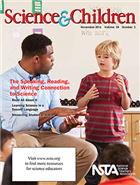 Science and Children – The Speaking, Reading, and Writing Connection to Science
Science and Children – The Speaking, Reading, and Writing Connection to Science
This issue is a must-read for teachers of all levels. The lessons described in the articles include connections with the NGSS.
- Read All About It has a good visual of how genres of children’s books can contribute different perspectives to children’s knowledge of and about science: folklore, fictional narrative biographies, fiction (realistic, historical, fantasy), and informational text (including websites and mobile apps, audio, video).
- Speaking and listening skills are often put on the back burner with the emphasis on reading test scores. By Dissecting Student Dialogue teachers can foster “collaborative conversations” to improve student skills.
- Introducing science notebooks to your students? Learning Science in a Second Language has some “boot camp” ideas and strategies.
- Supporting Academic Language describes strategies that encourage students to use scientific vocabulary and language, in both discussions and in their writing, including journal prompts, teacher support, language stems (see the Conclusion of the article for a plan).
- Sensing Matter—Is It a Liquid or Solid? Demonstrates, through a 5E lesson, how students can combine literacy skills with an activity in classifying matter.
- This month’s Poetry of Science column asks What Do Scientists Do?
- The 5E lessons in Teaching Through Trade Books: Recording Scientific Explorations focus on using age-appropriate writing, sketching, and labeling when documenting science investigations.
- The Early Years: Getting Deep With Documentation continues with the importance of recording scientific explorations with a discussion of why this is important and what this “storytelling” can look like in a PreK-2 classroom.
- Engineering Encounters: An Engineering Design Process for Early Childhood illustrates how young students can develop engineering design skills using the “egg-drop” activity.
- Methods and Strategies: Put Your Walls to Work by creating “interactive” word walls rather than the traditional static ones. There are several photographs of these student-created walls.
For more on the content that provides a context for these projects and strategies see the SciLinks topics Adaptations, Bird Adaptations, Invertebrates, Leonardo da Vinci, Mollusks, pH Scale, Solids Liquids and Gases, States of Matter
Continue for The Science Teacher and Science Scope
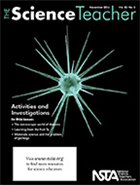
The Science Teacher – Activities and Investigations
In this issue, you’ll find science learning activities in a variety of contexts—biology, physics, ecology. The lessons described in the articles include connections with the NGSS.
- Materials Science and the Problem of Garbage asks the question “Where Does All That Stuff Go?” with a series of lessons in which students trace how materials are made and what happens environmentally to them when we’re finished.
- Learning From the Fruit Fly uses cards as models for students to explore how living things inherit traits from one generation to another.
- Science is not a static body of facts. In the activity, Settling the Score, students trace the history of our knowledge of atomic bonding using case studies.
- The Microscopic World of Diatoms is put into the context of analyzing stream water for pollutants.
- As students engage in online activities, you’ll want to read Science 2.0: When Students Become Digital Citizens to learn about the rights and responsibilities of digital citizenship.
- Focus on Physics: The Moon Is Falling! is an easy-to-read discussion of the topic with illustrations.
- The Green Room: Losing Sight of Our Stars suggests online resources for investigating light pollution and dark skies.
- Health Wise: Too Many Teens Have High Cholesterol notes that it’s never too early for students to learn about cardiovascular disease and how to prevent/control it.
- This month’s Idea Bank has suggestions for helping students with Measurement by the Numbers, a key part of many investigations.
For more on the content that provides a context for these projects and strategies see the SciLinks topics Avogadro’s Law, Cardiovascular Problems, Cardiovascular System, Chemical Bonding, Earth’s Moon, Genetic Variation, Gravity, Gravity and Orbiting Objects, Landfills, Measurements and Data, Meiosis, Mitosis, Projectile Motion, Punnett Squares, Recycling, Recycling Plastics, SI Measurement, Stars, Water Quality
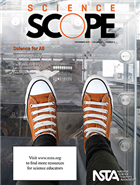
Science Scope – Science for All
“Science for all” is just that – meeting the needs of all learners by using a variety of strategies and recognizing the value of students’ interests, the importance of their backgrounds, and the interest they have in their communities. Featured articles that describe lessons include a helpful sidebar (“At a Glance”) documenting the big idea, essential pre-knowledge, time, and cost. The lessons also include connections with the NGSS.
- “Accelerating” Science Learning With Reading illustrates a 5S approach to guiding students through reading science texts (Structure, Speaker, Situation, Shifts, and Summary Statements).
- With genetics as the context, the authors of An Interdisciplinary Approach to Gene Therapy describe several literacy strategies, including TWLHQ (an extension of KWL organizers), Word Splashes, and discussion-based learning. The article includes examples of student work.
- Using Place-Based, Structured Inquiry to Motivate At-Risk Students has examples of how to involve students in real-world activities that connect science to their communities, including one in which students determine their carbon footprints.
- Classic Lessons 2.0: Science Cafés shows an inexpensive way to expose students to ideas (e.g., careers, STEM topics) that supplement and extend what happens in the classroom.
- Teacher’s Toolkit: Rocking Out Science! shows students creating music videos to share what they learn about ecology and interdependence. There are links to see their productions and suggestions for your classroom.
- Citizen Science: Fly Into Schoolyard Citizen Science With eBird describes an ongoing project in which students contribute to a global database that is used by scientists to study bird biology and behvior (and there is no cost to participate).
- Disequilibrium: Edible Candles has an example of how to address and model the differences between observations and inferences in a 5E lesson. (See the Safety note in the article.)
- Science for All: Accessibility at the Onset continues a discussion of strategies to get all students involved in classroom activities.
- Listserv Roundup: Four Essential Strategies for Differentiating Science Lessons has classroom –tested suggestions from our colleagues on the topic.
- Teacher to Teacher: Instructional Scaffolds Can Support Students
- The authors of Learning to Read Science discuss the importance of reading, writing, and talking in communicating and learning. They provide several strategies to support student reading with examples of graphic organizers and the pre-during-post model.
For more on the content that provides a context for these projects and strategies see the SciLinks topics Acceleration, Biodiversity, Bird Characteristics, Carbon Cycle, Careers in Science, Ecosystems, Forces, Genetics, Newton’s Laws, Phases of Matter, Punnett Squares, Science Misconceptions, Seasons
Educators at all levels will find ideas on helping students with Meeting the Challenges of Communicating Science in his month’s Science and Children. Many of the strategies can be adapted for other levels.
Positive environments: Early childhood education conferences
By Peggy Ashbrook
Posted on 2016-11-18
Two early childhood conferences I attended this month, a national conference and a local regional conference, were awash with sessions on science, STEM, and STEAM education. Although science education is my main focus, I enjoy attending conferences because in addition to the terrific learning experience, it always lifts my spirits. Something about large numbers of people who are working for a better future for others (children and ultimately our world), and who begin with the perspective of the child, gathered together creates a positive environment. I’m looking forward to attending and participating in a National Science Teachers Association conference in 2017.
 At the 2016 national conference of the National Association for the Education of Young Children (NAEYC), I saw educators displaying the skills we hope to instill in our students—observing, wondering, co-operating with a group, talking about the evidence for their ideas (what they saw and did), analyzing data, considering alternative explanations, trying new ideas, and using literacy and mathematics skills. While they worked together they also were planning how to include all children in science investigations when they returned back to their programs.
At the 2016 national conference of the National Association for the Education of Young Children (NAEYC), I saw educators displaying the skills we hope to instill in our students—observing, wondering, co-operating with a group, talking about the evidence for their ideas (what they saw and did), analyzing data, considering alternative explanations, trying new ideas, and using literacy and mathematics skills. While they worked together they also were planning how to include all children in science investigations when they returned back to their programs.
A three-hour session was still not long enough for many participants! They wanted additional time to even more fully experience and absorb the work shared by presenters. I attended two such sessions. Dr. Beth Van Meeteren, Director, and Sherri Peterson, Program Assistant, from the Regents’ Center for Early Developmental Education at UNI, presenting “Ramps and Pathways: A fun integration of science, technology, engineering, and mathematics,” and Cindy Hoisington, Senior Curriculum and Instructional Design Associate, from the Education Development Center, Inc., presenting “Let’s talk about it: Science as a vehicle for promoting English language learning for dual language learners.” In both sessions there was much talk and a lot of hands-on exploration as we considered the value of, and how to, incorporate engineering re-design into education for children up to age 8, and how we can design science explorations to meet several needs of dual language learners.
Presenting a session at a conference is easier when I do it with colleagues! Marie Faust Evitt, author of Thinking BIG Learning BIG, known as Teacher Marie at Mountain View Parent Day Nursery, and Sandy Chilton, Instructional Specialist and former preK bilingual teacher in the Austin Independent School District, joined with me to help participants “Picture science in your classroom: Deepen those fun explorations by connecting with the new standards.” We showed photos of children using the eight practices of science and engineering (NGSS Lead States 2013) as they engaged in science activities and inquiry, and then, at their tables, everyone identified those practices being used by children in additional photos. There were live and rubber red wiggler worms at the tables for the group to observe as they considered a question, such as, “How do red wiggler worms move?” Once again, we all wanted more time!
Choosing a session to attend usually meant there was another interesting session I could not attend. Take a look at the 2016 NAEYC conference program and follow these steps to access handouts and resources:
- Search by topic track, presenter, keyword, or date to find the session you are interested in.
- Click on the title of the session to open up a pop-up menu. Links to download handouts for the session are listed on the bottom of the pop-up page.
For example, Cindy Hoisington’s presentation has six documents to download.
Being part of several NAEYC Interest Forums is important to me so I can stay current with the early childhood education research and discussion on the topics of interest to the forums. If you are a member of NAEYC you can join any of the forums, and if you are not yet a member, you can connect through the forum’s social media pages. As a co-facilitator of the NAEYC Early Childhood Science Interest Forum (ECSIF), I invite you to join and share your experiences to add your voice. The annual meeting of the NAEYC ECSIF is where we talk about our successes, share an interesting video for discussion, and ask for help and plan to support science education in early childhood.
 The Northern Virginia Association for the Education of Young Children like many organizations, connects with people both on a website and on Facebook. Their regional conference brought together sessions on policy, the importance of movement in educating the whole child, brain development, play-based curriculum, building workplace relationships, coaching, science inquiry, and welcoming all in inclusive classrooms, among others.
The Northern Virginia Association for the Education of Young Children like many organizations, connects with people both on a website and on Facebook. Their regional conference brought together sessions on policy, the importance of movement in educating the whole child, brain development, play-based curriculum, building workplace relationships, coaching, science inquiry, and welcoming all in inclusive classrooms, among others.
We heard comments supportive of the value of early childhood education from Outstanding Service to Young Children Award Recipient Linda K. Smith, the Deputy Assistant Secretary for Early Childhood Development, Administration for Children and Families, U.S. Department of Health and Human Services. She encouraged us to share the importance of our work with people outside of the profession.
The conferences affirmed my sense that making quality early childhood education available for all children will make our world a better place for all. And I learned more about teaching science concepts to young children and supporting their science inquiries into questions that interest them.
 The National Science Teachers Association is currently accepting proposals for the following conferences. What session will you propose to share your experiences and knowledge with other educators? Which conference will be possible for you to attend in 2017? To check out the NSTA submission guidelines, click here.
The National Science Teachers Association is currently accepting proposals for the following conferences. What session will you propose to share your experiences and knowledge with other educators? Which conference will be possible for you to attend in 2017? To check out the NSTA submission guidelines, click here.
6th Annual STEM Forum & Expo at Gaylord Palms Resort/Kissimmee, Orlando: July 12–14, 2017. Submission Deadline closes at 11:59 PM ET – Jul 14, 2017 Dec 5, 2016
Baltimore Area Conference: October 5–7, 2017. Submission Deadline closes at 11:59 PM ET Jan 17, 2017
Milwaukee Area Conference: November 9–11, 2017. Submission Deadline closes at 11:59 PM ET Jan 17, 2017
New Orleans Area Conference: November 30–December 2, 2017. Submission Deadline closes at 11:59 PM ET Jan 17, 2017
Atlanta National Conference: March 15–18, 2018. Submission Deadline closes at 11:59 PM ET Apr 17, 2017
Adding your voice on topics in science education that are important to you will support the rest of us as we build a strong system for early childhood education. Invite a colleague to put in a proposal with you—they will be honored to be asked.
Two early childhood conferences I attended this month, a national conference and a local regional conference, were awash with sessions on science, STEM, and STEAM education. Although science education is my main focus, I enjoy attending conferences because in addition to the terrific learning experience, it always lifts my spirits. Something about large numbers of people who are working for a better future for others (children and ultimately our world), and who begin with the perspective of the child, gathered together creates a positive environment.
Health Wise: Too Many Teens Have High Cholesterol
By sstuckey
Posted on 2016-11-18
About one in five U.S. kids and teens ages 6 to 19 has abnormal cholesterol levels, according to the National Center for Health Statistics (NCHS 2015). And among the 16-to-19 age group, the number rises to more than one in four.
“[This] is concerning because high cholesterol levels are a major factor contributing to heart disease and stroke,” says Mary Lou Gavin, MD, a pediatrician specializing in weight management and senior medical editor at KidsHealth.org. “Research shows that cardiovascular disease has its roots in childhood.”
Cholesterol is a lipid, or fat. The body uses cholesterol to help digest fatty foods and form cell membranes and hormones (progestagens, glucocorticoids, mineralocorticoids, androgens, and estrogens). The liver produces about 1,000 mg of cholesterol daily, which is enough for healthy functioning. Fruit, vegetables, and grains don’t have any cholesterol. Dietary cholesterol comes from:
- dairy products (e.g., milk, cheese, and ice cream),
- egg yolks,
- meat,
- poultry, and
- seafood.
To travel through the bloodstream, cholesterol has to combine with proteins. The combination of cholesterol and proteins is called lipoproteins. Low-density lipoproteins (LDL), or “bad cholesterol,” are the primary cholesterol carriers. Too much LDL in the bloodstream can build up inside blood vessels. The buildup forms plaque—a hard substance that can cause blood vessels to become stiffer, narrower, and blocked. Plaque makes it easier for blood clots to form. A blood clot can cause a heart attack or stroke.
High-density lipoproteins (HDL), or “good cholesterol,” on the other hand, carry cholesterol away from the arteries and back to the liver, where it’s processed and sent out of the body. HDLs might even help remove cholesterol from areas of plaque. High levels of LDL increase heart disease and stroke risks. High levels of HDL can help protect the circulatory system. Here’s a mnemonic to remember good versus bad cholesterol: LDL starts with “l” for “lousy”; HDL starts with “h” for “healthy.”
Total cholesterol, based primarily on levels of LDL and HDL cholesterol, is a measure of the total amount of cholesterol in the blood. The combination of high levels of LDL and low levels of HDL indicates an increased risk of heart attack and stroke.
According to the U.S. Centers for Disease Control and Prevention (CDC 2015), desirable cholesterol levels for adults are:
- LDL = less than 100 mg/dl
- HDL = 60 mg/dl or higher
- Total cholesterol = less than 200 mg/dl
According to Gavin, desirable levels for kids and teens are:
- LDL = less than 110 mg/dl
- HDL = 40 mg/dl or higher
- Total cholesterol = less than 170 mg/dl
Factors that can contribute to high cholesterol levels include:
- eating foods high in fats, especially saturated and trans fats;
- having a parent with high cholesterol;
- being obese, related to diet and exercise; and
- having diabetes.
The study by the NCHS shows that teens ages 16 to 19 were most likely to have high total cholesterol, high LDL, or low HDL (26.9% for ages 16 to 19 versus 21.0% for ages 6 to 19 overall). This is why your students should know about:
- the need for screening to learn their cholesterol levels and
- how a healthy diet and daily exercise can help improve cholesterol levels.
Classroom activity
Ask your students to write an essay addressing the following question: The American Academy of Pediatrics recommends (AAP 2011) that all children be screened for high cholesterol at least once between ages 9 and 11 years and between ages 17 and 21 years. Why? Resources cited below are appropriate for their research.
Michael E. Bratsis (mbratsis@kidshealth.org) is senior editor for Kids Health in the Classroom (kidshealth.org/classroom). Send comments, questions or suggestions to mbratsis@kidshealth.org.
On the web
Article, video, quiz for students: http://teenshealth.org/en/teens/cholesterol.html, http://bit.ly/lipo-science-vid, http://bit.ly/cholesterol-quiz
References
American Academy of Pediatrics (AAP). 2011. Physicians recommend all children, ages 9–11, be screened for cholesterol. http://bit.ly/2cgI1mQ
Centers for Disease Control and Prevention (CDC). 2015. Cholesterol fact sheet. http://bit.ly/1pz0zxh
National Center for Health Statistics (NCHS). 2015. Abnormal cholesterol among children and adolescents in the United States, 2011–2014 http://bit.ly/cholesterol-kids
Editor’s Note
This article was originally published in the November 2016 issue of The 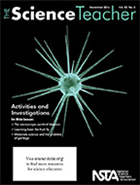 Science Teacher journal from the National Science Teachers Association (NSTA).
Science Teacher journal from the National Science Teachers Association (NSTA).
Get Involved With NSTA!
Join NSTA today and receive The Science Teacher,
the peer-reviewed journal just for high school teachers; to write for the journal, see our Author Guidelines, Call for Papers, and annotated sample manuscript; connect on the high school level science teaching list (members can sign up on the list server); or consider joining your peers at future NSTA conferences.









